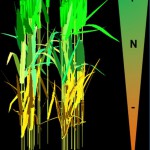CN-Wheat
Romain Barillot, Camille Chambon and Bruno Andrieu (INRA-ECOSYS)
Overview
| Model category | FSPM |
|---|---|
| Plant part | Whole_plant |
| Scale | Organs, Whole_plant |
| Licence | open_source |
| Operating system | Windows, Linux |
| Programming language | Python |
| Format of model inputs and outputs | CSV files |
| Species studied | Wheat |
| Execution environment | Console |
| Modelling environment | OpenAlea |
Scientific article
CN-Wheat, a functional–structural model of carbon and nitrogen metabolism in wheat culms after anthesis. I. Model descriptionRomain Barillot,Camille Chambon and Bruno AndrieuAnnals of Botany, 2016-10 View paper
Model description
CN-Wheat is a comprehensive and mechanistic model of carbon (C) and nitrogen (N) metabolism simulating resource acquisition and allocation in wheat. The first version of CN-Wheat was developed for post-anthesis stages meaning that the growth of photosynthetic organs is not represented. The model is defined at culm scale, which is represented by botanical modules: the root system, each photosynthetic organ, the grains and a common pool mimicking the phloem and allowing fluxes of metabolites among organs. Each organ includes structural, mobile (sucrose, nitrates, and amino acids) and storage (fructans, proteins) materials. Metabolite variations are represented by differential equations that depend on the main physiological processes: photosynthesis, respiration, mineral N uptake, synthesis, degradation and remobilisation of C-N metabolites, senescence, and grain filling. The originality of the model lies in the regulation of these processes by both environmental factors and metabolites concentrations at the local organ scale. As emergent properties, the model is able to simulate the shoot: root ratio, green area dynamics and grain yield under contrasted conditions of light and N fertilisation.
Some case studies
Some recent studies using CN-Wheat:
- Grain yield and leaf senescence under contrasting N fertilisations at anthesis
- Investigation of complex canopies composed by wheat plants with contrasted leaf inclination



